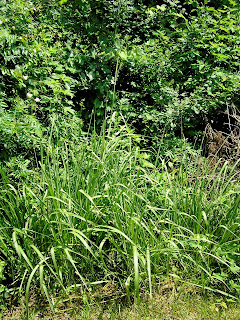On the south side of the W&OD bike path, west of its intersection with the driveway for the Oak Hill Christian School, is this patch of grass. The grass is characterized by short but blunt-based blades that fully clasp the stem and by a paniculate seedhead. This appears to be deer-tongue grass (Dichanthelium clandestinum, compare this Virginia Tech weed guide).
A far more prominent species of grass is Eastern gamagrass (Tripsacum dactyloides, see this Missouri description), which forms large clumps of rather tall stands (up to chest-height), as here on the north side of the W&OD bike path just east of Isaac Newton Square. The rather broad leaves have a prominent keel formed by a whitish midrib.
At present the Eastern gamagrass is beginning to bloom, with a profusion of brown male flowers at the top of a jointed flowerhead and rather wispy purple flowers further down.
Another view of this particular flowering specimen, which I found to be very difficult to photograph; for much sharper pictures, see the Missouri description linked to above.
Often encountered along the side of the W&OD bike path right now is this lacey flower with its flat-topped head of white flowers. It may look like Queen Anne's lace, but is actually the common yarrow (Achillea millefolium), distinguished by the deeply dissected leaves (almost needle-like from a distance) that give it the specific name "thousand-leaved". See this Wikipedia article and this Missouri description.
Rather less common is this somewhat larger white flower, here shown on the south side of the W&OD bike path opposite the Fannie Mae Gardens. This is clearly some sort of daisy, of which the most commonly found wild variety around here is the oxeye daisy (Leucanthemum vulgare, see this Wikipedia article and this Missouri description.
Here a shaft of light illuminates the perfect bipinnately compound leaves of a mimosa or Persian silk tree (Albizia julibrissin, see this Virginia Tech fact sheet and this Wikipedia article) found on the east side of the W&OD gravel path just north of its intersection with Sunset Hills Drive.






